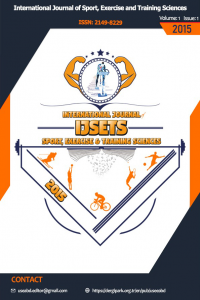Network dynamics-based tactic of combat for Taekwondo to identify keys patterns
Taekwondo, Discrete Dyanamic System, , Attraction Basins
Network dynamics-based tactic of combat for Taekwondo to identify keys patterns
Taekwondo, Attraction Basins, Discrete Dynamic System,
___
- Altarriba-Bartes, A., Drobnic, F., Til, L., Malliaropoulos, N., Montoro, J. B., & Irurtia, A. (2014). Epidemiology of injuries in elite taekwondo athletes: two Olympic periods cross-sectional retrospective study. BMJ open, 4(2), e004605. DOI: 10.1136/bmjopen-2013-004605
- Barnett, T., and Pollard, G. H. (2011). Revising new Australian rules football scoring systems. J. Quant. Anal. Sports 7, 23–29
- Beatriz Luna, Edgardo Ugalde (2008), Dominant vertices in regulatory networks dynamics, Physica D: Nonlinear Phenomena, 237,2685-2695, DOI; 10.1016/j.physd.2008.04.007.
- Benítez, M., Espinosa-Soto, C., Padilla-Longoria, P. et al. Las subredes no lineales interconectadas subyacen a la formación de patrones celulares robustos en la epidermis de Arabidopsis : un modelo espacial dinámico. BMC Syst Biol 2, 98 (2008). DOI: 10.1186/1752-0509-2-98
- Bolotin, A., & Bakayev, V. (2018). Pedagogical practice for development of coordination potential of MMA fighters and estimation of its efficiency. Journal of Human Sport and Exercise, 13(1), 72-88. oi:https://doi.org/10.14198/jhse.2018.131.08
- Castellano, J., Hernández-Mendo, A., Morales-Sánchez, V., and Anguera, M. T. (2007). Optimising a probabilistic model of the development of play in soccer. Qual. Quant. 41, 93–104. doi: 10.1007/s11135-005-3148-0
- Casolino, E., Lupo, C., Cortis, C., Chiodo, S., Minganti, C., Capranica, L., et al. (2012). Technical and tactical analysis of youth taekwondo performance. J. Strength Cond. Res. 26, 1489–1495. doi: 10.1519/JSC.0b013e318231a66d
- Espinosa Soto, C., Martin, O.C. and Wagner, A. (2011), Phenotypic robustness can increase phenotypic variability after non genetic perturbations in gene regulatory circuits. Journal of Evolutionary Biology, 24: 1284-1297. DOI:10.1111/j.1420-9101.2011.02261.x
- Follmer, B., Dellagrana, RA y Zehr, EP (2019). La exposición a traumatismos craneales en las artes marciales mixtas varía según el sexo y la clase de peso. Salud deportiva , 11 (3), 280–285. DOI:10.1177/1941738119827966
- Gréhaigne, J. F., and Godbout, P. (1995). Tactical knowledge in team sports from a constructivist and cognitivist perspective. Quest 47, 490–505. doi: 10.1080/ 00336297.1995.10484171.
- Goldner, K. (2012). A Markov model of football: using stochastic processes to model a football drive. J. Quant. Anal. Sport 8, 1–18. doi: 10.1515/1559-0410. 1400
- Gottman, J. M., and Roy, A. K. (1990). Sequential Analysis. A Guide for Behavioral Researchers. New York, NY: Cambridge University Press.
- McGarry, T., and Franks, I. M. (1994). A competition squash match-play. J. Sports Sci. 12, 573–584. doi: 10.1080/02640419408732208
- Menescardi Cristina, Falco Coral, Ros Concepción, Morales-Sánchez Verónica, Hernández-Mendo Antonio (2019), Development of a Taekwondo Combat Model Based on Markov Analysis, Frontiers in Psychology, 10, 2188, DOI:10.3389/fpsyg.2019.02188.
- Menescardi, C., López-López, J. L., Falco, C., Hernández-Mendo, A., and Estevan, I. (2015). Tactical aspects of a national university taekwondo championship in relation to round and match outcome. J. Strength Cond. Res. 29, 466–471. doi: 10.1519/JSC.0000000000000645
- Menescardi, C., Estevan, I., Falco, C., and Hernández-Mendo, A. (2017). Generalizability theory applied to Olympic taekwondo combats. Eur. J. Hum. Mov. 39, 65–81.
- Miarka, B., Julio, U., Del Vecchio, F., Calmet, M. y Franchini, E. (2012). Técnica y táctica en judo: una revisión. Revista de Artes Marciales Asiáticas, 5 (1), 91-112. doi: http://dx.doi.org/10.18002/rama.v5i1.139
- Petrisor, B. A., Del Fabbro, G., Madden, K., Khan, M., Joslin, J., & Bhandari, M. (2019). Injury in Brazilian Jiu-Jitsu Training. Sports health, 11(5), 432–439. doi.org/10.1177/1941738119849112
- Pappas E. (2007). Boxing, wrestling, and martial arts related injuries treated in emergency departments in the United States, 2002-2005. Journal of sports science & medicine, 6(CSSI-2), 58–61.
- Son, B., Cho, Y. J., Jeong, H. S., & Lee, S. Y. (2020). Injuries in Korean Elite Taekwondo Athletes: A Prospective Study. International journal of environmental research and public health, 17(14), 5143.DOI:10.3390/ijerph17145143
- O’Donoghue, P. (2010). Research Methods for Sports Performance Analysis. New York, NY: Routledge.
- Ozcinar, H., and Ozturk, H. T. (2013). “Methods for analyzing computer-mediated communication in educational sciences,” in Advancing Research Methods With New Media Technologies, ed. N. Sappleton (London: IGI Global), 228–249. doi: 10.4018/978-1-4666-3918-8.ch013
- Tarragó, R., Iglesias, X., Lapresa, D., Anguera, M. T., Ruiz, L., and Arana, J. (2017). Analysis of diachronic relationships in successful and unsuccessful behaviors by world fencing champions using three complementary techniques. Anal. Psicol. 33, 471–485. doi: 10.6018/analesps.33.3.271041
- ISSN: 2149-8229
- Başlangıç: 2015
- Yayıncı: İbrahim ERDEMİR
Physiological Performance Characteristics of Male and Female Division I Cross-Country Runners
Eric SOBOLEWSKİ, Jacquelyn CROW, Scott MURR, Randy HUTCHISON
Network dynamics-based tactic of combat for Taekwondo to identify keys patterns
David RAMÍREZ, Teodoro CÓRDOVA
Engelli Sporcularda Psikolojik İyi Oluş ve Serbest Zaman Doyumu Arasındaki İlişkinin İncelenmesi
Rıfat Kerem GÜRKAN, Funda KOÇAK, Aral BAŞAR
